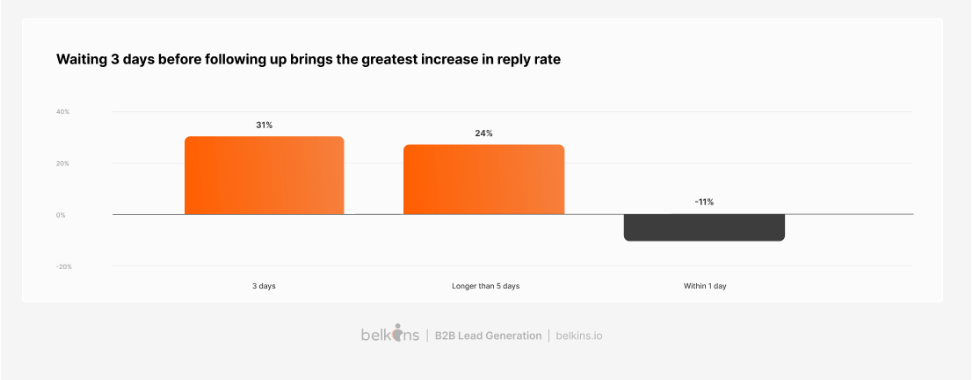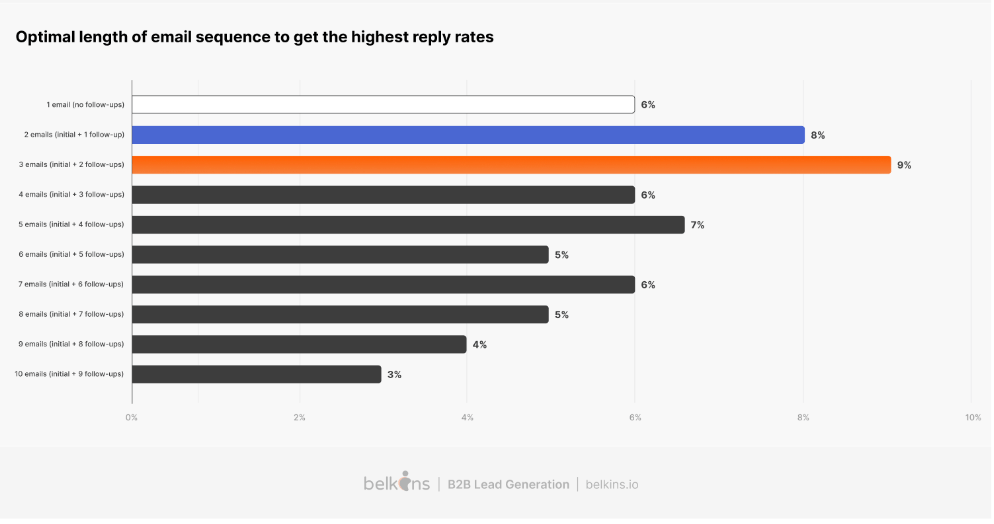Email follow up strategies are essential in the business world. Having an effective plan for staying in touch with clients and colleagues can be the difference between success and failure.
Conversions from leads to deals don’t come easy. Whether because of bad timing or wrong messaging, even warmed-up leads sometimes aren’t ready to buy. While you may not always be able to identify the causes, you can still ask them why or send a new value prop. But for some reason, 48% of salespeople never try to follow up and ask the right questions.
At the same time, your potential clients receive around 170 emails weekly, which makes your message compete with numerous offers and promotions. Your email must be personal and relevant to stand out and resonate with the recipient. Also, it’s important to balance persistence without becoming annoying, as being too pushy can lead to opt-outs or spam filters.
So, in this article, we’ll explore why email follow-ups are crucial for an effective lead generation strategy and how to do them right.
Hire an email marketing consultant for your business.
The Value of Follow-Up Emails in B2B
Sending a follow-up email after the initial outreach in B2B is like taking that crucial second step in building a relationship. It’s not just a courtesy; it’s a strategy that serves several purposes:
- Reinforce your presence. If you got no answer to the first email, your message might not resonate with your recipients. Here’s where follow-ups come in handy. They serve as a gentle reminder you’re still here, and give you another chance to communicate the value you can provide.
- Shows your involvement. A follow-up email sends a clear signal you’re genuinely interested in engaging with the recipient. It shows you’re not merely sending out mass emails but want to invest time and effort in a personalized conversation.
- Addresses missed opportunities. Sometimes, the recipient can miss your email or switch to another issue and forget about it. Sending a follow-up, you can try to grab their attention once more.
Most importantly, follow-up emails can help you build trust. You can stuff them with additional information, resources, or solutions tailored to the recipient’s needs. This demonstrates your expertise and reliability, which are key to building trust.
Overall, a well-timed follow-up email showcases your commitment and professionalism.
Nurturing Leads Through Email Sequences
Consider creating a follow-up sequence that includes multiple touchpoints over time. This helps nurture the lead and build a relationship with them gradually.
An in-depth analysis of more than 11 million emails shows that:
- Outreach campaigns with 3 email rounds tend to have the highest reply rates (9.2%).
- The first follow-up email is the most effective, boosting the reply rate by 49%.
- The second follow-up increases the reply rate by only 9%, while the third follow-up email decreases the reply rate by 20%.
While showing interest is essential, avoid using high-pressure language or tactics that could make the recipient feel uncomfortable. Respect their time and decision-making process. Our research found that waiting 3 days before following up brings the most significant increase in reply rate (31%). We also discovered that it’s better to wait for 2–5 days before following up.

Thus, by building the right follow-up process, you can efficiently nurture leads and ensure your brand stays at the forefront of their decision-making process, making them more likely to convert when the time is right.
Crafting Compelling Follow-up Emails
Your initial outreach may have piqued interest, but it’s the follow-up that nurtures the connection, addresses concerns, and convinces prospects to take action. Writing a good follow-up email isn’t a matter of chance; it’s an art based on the best practices. Here are a few tips on how to create follow-ups that grab attention and leave a lasting impact.
Go for Personalization
It’s not just about using the recipient’s name. It’s about showing you’ve done your homework and understand the potential client’s context.
- Tip #1: Reference specific details from prior interactions, such as their website visit or downloaded content. This demonstrates that your message isn’t generic but tailored to their journey. You can also research some tools or services the company is using, if relevant.
- Tip #2: Use conversational language as if speaking to them directly. Avoid jargon or overly formal tones, which can create an artificial distance.
Create Irresistible Subject Lines
It’s quite obvious, but your subject line stimulates the recipient to open your email and explore it further. Be it a catchy question, benefit, or statement, the subject line must engage and entice. It should either pique curiosity or clearly convey the purpose of your email.
- Tip #3: Avoid generic language and keep it concise. Some email clients can crop lengthy text. Research by Sopro suggests that subject lines from 3 to 7 words tend to bring the best open rates.
- Tip #4: Test different subject lines to see what resonates with your audience. A/B testing can reveal which approach drives higher open rates.
Make Value Proposition Count
The essence of your follow-up email lies in the value you offer. Whether it’s a solution to your lead’s pain points, a new opportunity, or insightful information, your message should articulate why engaging with you is worth their time.
- Tip #5: Be explicit about the benefits. Explain how your product or service solves their challenges or helps achieve their goals.
- Tip #6: Use specific examples or case studies to illustrate the real-world impact of your offerings.
Offer the Clear CTA
A follow-up email without a call to action (CTA) is like a map without a destination point. Your CTA guides the recipient on to the next steps, whether it’s scheduling a call, requesting more information, or downloading a resource.
- Tip #7: Use more specific phrases like “Discover how [your solution] can boost your ROI” instead of the generic “Learn more.”
- Tip #8: Add only one CTA. Articulate the next steps clearly, without confusing your recipient about what to choose—book a call or read more information.
A/B Test to Scale Winning Approaches
A strategy that is effective today might not work tomorrow. A/B testing is your way to regularly measure what drives more engagement and conversions. Experiment with different email content, subject lines, and sending times to improve your follow-up strategy step by step.
- Tip #9: Test one variable at a time to isolate the impact of each change. This helps you fine-tune your emails effectively.
- Tip #10: Don’t forget to analyze the data. Track open rates, click-through rates, and conversion rates. Use this information to iterate and refine your follow-up emails.
Timing and Frequency
The key is to strike a balance between being persistent enough to maintain engagement and respecting a lead’s space to avoid overwhelming them. Based on research, two follow-up emails are a great choice for B2B cold outreach campaigns. A typical timeframe for the interval between emails is 3–5 days.

There’s no one-size-fits-all approach to determining the ideal timing for sending emails. It varies depending on many factors, including industry and even cultural specifics. However, here are some insights my team has discovered after we analyzed 11 million emails sent by our clients across 90+ industries:
- Wednesday is the best day of the week to send outreach emails, with the highest reply rates of 7.2% and open rates of 37%.
- Mondays have the lowest open rates of under 35% and reply rates of around 6.5%.
- Open rates peak at roughly 41% in the afternoon, between 12 PM and 4 PM.
- Reply rates are highest in the morning, between 7 AM and 11 AM.
By being mindful of lead preferences, providing value, and utilizing various communication channels, you can optimize your follow-up approach to foster engagement and drive conversions.
To Sum It Up: Key Tips to Master Your Email Follow-Ups
Email follow-up strategies are not just an add-on to your B2B lead generation efforts; they are the backbone of successful outreach campaigns. Let’s rewind the core tactics to keep them thrive:
- Personalize emails by adding tailored information about the client’s company. Keep your language true to life.
- Choose shorter subject lines and test them to drive higher open rates.
- Articulate the value your potential client will get.
- Add a clear call to action.
- A/B test different texts, tactics, and approaches to find the best performing ones.
In the dynamic landscape of B2B lead generation, you should be able to adapt to a changing environment for optimum performance. So, don’t be afraid to experiment and refine your follow-up strategies accordingly.
Additional Reading: